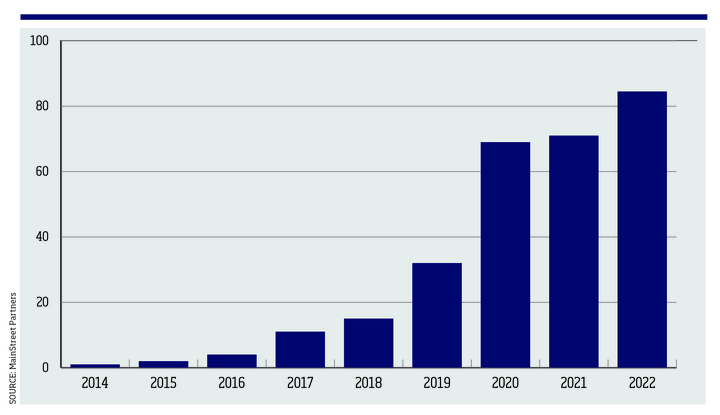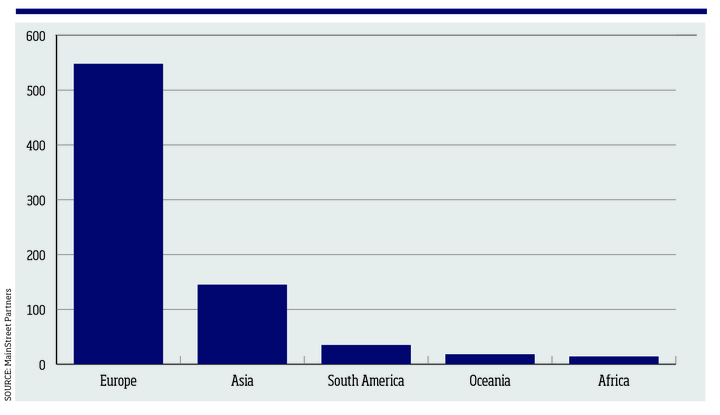The rapid rise of investment funds specifically targeting the UN Sustainable Development Goals (SDGs) has not translated into a focus on where those funds are flowing geographically.
As finance services co-opted the SDGs - a blueprint of 17 interlinked global objectives to protect people and planet by 2030 - from government policymakers, new financial instruments were introduced.
The first ‘green bond' was launched in 2008 by the World Bank, and green, social and sustainability (GSS) bonds have subsequently flourished into a $3.5trn market, which goes some way to meeting the estimated $2.5trn annual funding gap required to hit the UN's 2030 target.
Emerging markets beneficiary
Our latest GSS bond report found that regardless of the geographic location of a GSS bond's issue, the proceeds are increasingly being directed towards emerging markets.
‘Use of proceeds' refers to the projects or activities being funded by the bond in order to address or mitigate a specific social or environmental issue.
Sustainable bond funds shed £653m in H1 2023 as ESG equities add £10.3bn
So, the report highlights that sustainable fixed income securities are increasingly being used where the project or activity is based in an emerging market.
This is big - and important - news. Why?
Because the targets set by the Paris Agreement and the SDGs can only be met if developed and developing market stakeholders work collectively towards their advancement. While investors are expected to play a significant role, cross-border financing of SDG-linked investments had been falling in most recent years.
Global foreign investment flows, a key source of funding for developing markets, were under significant pressure during the pandemic, and fell 42% in 2021 compared to 2019.
Supranational entities often use GSS bonds to support capital investments internationally, and especially in emerging markets.
Article 9 funds receive lowest inflows on record as Article 8 products face outflows
The relationship between the country of domicile and the location of investment is not always clear-cut, but capital channelled towards developing markets has been steadily rising since 2016, as issuers and investors increasingly embraced the aim of building up climate financing in the most vulnerable regions established with the Paris Agreement in 2015.
There has been a 125% increase in proceeds allocated to emerging markets in 2021 compared with 2019.
GSS bonds proceeds invested in emerging markets annually ($bn)

South America saw the largest increase in use of proceeds to its impact projects in 2021, however Europe takes the lion's share of use of proceeds - $548bn as of end of 2022 - almost four times the investment inflows of the next largest region to benefit, Asia (at $145bn).
Emerging market projects by issuer region ($bn)

What this imbalance between emerging and developed markets' use of proceeds for SDG-linked initiatives means is that regions most exposed to the risk of climate change are also those with less means to finance their transitions.
That includes climate change mitigation (e.g. renewable energy solutions) and adaptation solutions (e.g. flood protections).
Our GSS bond report found the most popular SDGs targeted by issuers are related to clean energy, healthcare and the environment. The five most common SDGs in 2022 were present in 46% of frameworks, highlighting a strong focus on few key topics.
Majority of funding in 2022 was dedicated to five SDGs

GSS bond emerging markets issuance
Although Mexico issued the world's first sovereign SDG bond, emerging markets' own issuance of GSS bonds remains a fraction of the rest of the world's, accounting for just 9% of the total in 2022.
However, this represents an upwards trajectory, tripling the volume of GSS bond issuances from emerging markets within seven years (from 2015).
China remains the largest market for GSS bond issuance in emerging markets, accounting for over 60% of total issuance since 2015, although the number of issuers has also expanded significantly. Our database sees GSS bonds issued from 35 emerging markets as of 2022, compared with eight in 2015.
UK ministers: 'Perverse' divestment from defence over ESG puts security at risk
It is widely believed that in a few years' time we will be left with fossil fuel resources that cannot be burned and fossil fuel infrastructure (e.g. pipelines, power plants) that is no longer used and may end up as a liability before the end of its anticipated economic lifetime.
In order to avoid the cost of ‘stranded assets' in the medium term, emerging markets must scale policy and investment into sustainable activities.
Conclusion
GSS bonds can be deployed as traditional bonds, with the additional feature of deploying capital towards environmental and social projects (the use of proceeds).
Providing mapping between use of proceeds and the SDGs has become an increasingly common practice in the GSS bonds market, especially within pre-issuance documents published by issuers (e.g. Green Bond Frameworks).
In 2022, 63% of GSS bonds provided an explicit SDG mapping in pre-issuance documents, up from just 10% in 2016. This highlights the increasing transparency and maturity of this market.
However, lack of financing remains a major obstacle to achieving the SDGs, and it is most acute in emerging markets. Although GSS bonds are helping, the number of SDG-linked projects have actually decreased more in emerging markets than developed markets during Covid.
To reiterate, the UN SDGs and Paris Agreement commitments can only be met with considerable contribution from developed and emerging markets. GSS bonds don't pretend to offer a panacea, but with more financial instruments available, institutional investors can safeguard long-term investments and scale solutions to narrow that $2.5trn annual funding gap.
Pietro Sette is research director at MainStreet Partners










